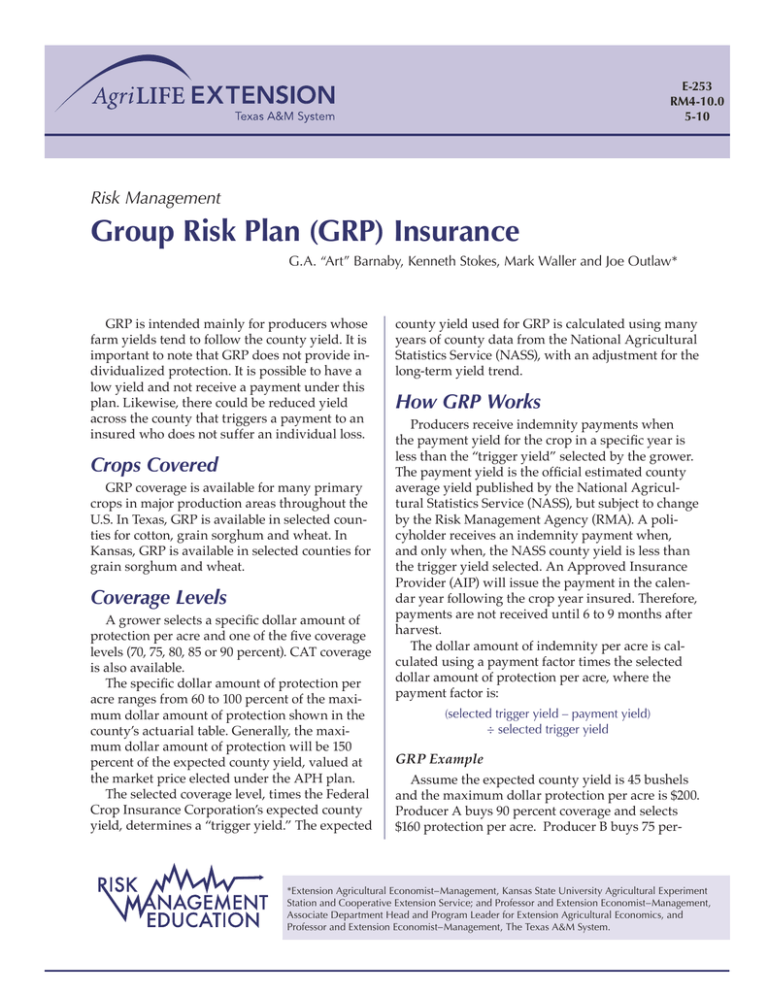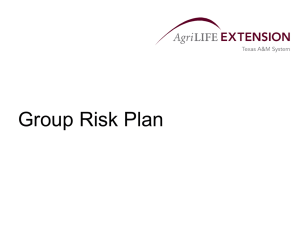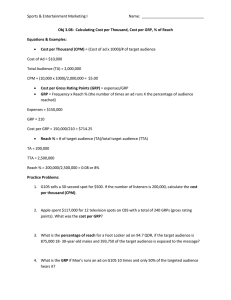Group Risk Plan (GRP) Insurance Risk Management
advertisement

E-253 RM4-10.0 5-10 Risk Management Group Risk Plan (GRP) Insurance G.A. “Art” Barnaby, Kenneth Stokes, Mark Waller and Joe Outlaw* GRP is intended mainly for producers whose farm yields tend to follow the county yield. It is important to note that GRP does not provide individualized protection. It is possible to have a low yield and not receive a payment under this plan. Likewise, there could be reduced yield across the county that triggers a payment to an insured who does not suffer an individual loss. Crops Covered GRP coverage is available for many primary crops in major production areas throughout the U.S. In Texas, GRP is available in selected counties for cotton, grain sorghum and wheat. In Kansas, GRP is available in selected counties for grain sorghum and wheat. Coverage Levels A grower selects a specific dollar amount of protection per acre and one of the five coverage levels (70, 75, 80, 85 or 90 percent). CAT coverage is also available. The specific dollar amount of protection per acre ranges from 60 to 100 percent of the maximum dollar amount of protection shown in the county’s actuarial table. Generally, the maximum dollar amount of protection will be 150 percent of the expected county yield, valued at the market price elected under the APH plan. The selected coverage level, times the Federal Crop Insurance Corporation’s expected county yield, determines a “trigger yield.” The expected county yield used for GRP is calculated using many years of county data from the National Agricultural Statistics Service (NASS), with an adjustment for the long-term yield trend. How GRP Works Producers receive indemnity payments when the payment yield for the crop in a specific year is less than the “trigger yield” selected by the grower. The payment yield is the official estimated county average yield published by the National Agricultural Statistics Service (NASS), but subject to change by the Risk Management Agency (RMA). A policyholder receives an indemnity payment when, and only when, the NASS county yield is less than the trigger yield selected. An Approved Insurance Provider (AIP) will issue the payment in the calendar year following the crop year insured. Therefore, payments are not received until 6 to 9 months after harvest. The dollar amount of indemnity per acre is calculated using a payment factor times the selected dollar amount of protection per acre, where the payment factor is: (selected trigger yield – payment yield) ÷ selected trigger yield GRP Example Assume the expected county yield is 45 bushels and the maximum dollar protection per acre is $200. Producer A buys 90 percent coverage and selects $160 protection per acre. Producer B buys 75 per- *Extension Agricultural Economist−Management, Kansas State University Agricultural Experiment Station and Cooperative Extension Service; and Professor and Extension Economist−Management, Associate Department Head and Program Leader for Extension Agricultural Economics, and Professor and Extension Economist−Management, The Texas A&M System. cent coverage and selects $185 protection per acre. Both producers have 100 percent share in the crop and both plant 200 acres of the crop in the county. The unsubsidized premium rates for 75 and 90 percent coverage are $3.30 and $6.14 per hundred dollars of protection, respectively. The subsidized premium rates for 75 and 90 percent coverage are $1.35 and $3.01 per hundred dollars of protection, respectively. A’s “trigger yield” is 40.5 bushels per acre (90 percent of 45). A’s policy protection is $32,000 ($160 x 200 acres). The premium for A’s policy is $963, which is the total premium of $1,965 ($160 x $6.14 x 200 acres x .01) less the federal subsidy of $1,002 (total premium of $1,965 x 51 percent subsidy rate). B’s “trigger yield” is 33.8 bushels per acre (75 percent of 45). B’s policy protection is $37,000 ($185 x 200 acres). The premium for B’s policy is $500, which is the total premium of $1,220 ($185 x $3.30 x 200 acres x .01) less the federal subsidy of $720 (total premium of $1,220 x 59 percent subsidy rate). level, times .01, less the applicable subsidy. The subsidy is a percentage of the total premium. Group Risk Plan Subsidies and Fees Coverage level Trigger yield Unsubsidized rate GRP premium subsidy Fee CAT 29.3 2.14 1.00 $300 GRP Features 70% 31.5 2.64 0.59 $30 75% 33.8 3.30 0.59 $30 80% 36.0 3.91 0.55 $30 85% 38.3 4.87 0.55 $30 90% 40.5 6.14 0.51 $30 • GRP is a simple way to manage risk because the only information required of the producer is the number of acres planted. This must be turned in by the acreage reporting date. • GRP often provides the lowest cost protection against widespread crop losses. • GRP requires significantly less paperwork than Actual Production History (APH) crop insurance. GRP has no field loss adjustment or claim record requirement. • Insurable acreage is acreage planted on or before the acreage reporting date, which is beneficial because: 1) there is no special rate for high-risk ground; 2) the APH map of uninsurable land does not apply; and 3) practices that are uninsurable for APH are insured for GRP. • There is a wider range of coverage levels, and GRP has higher dollar coverage levels than APH. • GRP reduces fraudulent claims. • There is limited adverse selection or moral hazard. Premium rates are based on historical county yields. • The program gives producers an additional risk management tool. • The program may be attractive to farmers who use unusual crop rotation. • A farmer with several crop losses in a row may have better coverage with GRP than APH because of the reduced program yield. However, if the losses are caused by poor management the GRP will not provide protection. • GRP works well for large farming operations that have land widely dispersed throughout the county. Scenario 1 (likely) Based on the NASS estimate of the county yield, RMA announces a payment yield of 46 bushels per acre. This is above the trigger yield for both producers A and B, so no indemnity payment is made, even if they have low yields. Scenario 2 (less likely) RMA issues a payment yield of 38 bushels per acre. A’s payment calculation factor is 0.062 [(40.5 – 38.0) ÷ 40.5]. A’s payment factor is multiplied by the policy protection and results in an indemnity payment of $1,984 (.062 x $32,000). B’s trigger yield is below the payment yield, so no payment is made. Scenario 3 (least likely) RMA issues a payment yield of 22 bushels per acre. A’s payment calculation factor is 0.457 [(40.5 – 22.0) ÷ 40.5]. A’s indemnity payment is $14,624 (.457 x $32,000). B’s payment calculation factor is 0.349 [(33.8 – 22.0) ÷ 33.8]. B’s payment factor is multiplied by the policy protection and results in an indemnity payment of $12,913 (.349 x $37,000). Premiums The annual premium amount is determined by multiplying the selected dollar amount of protection per acre times the unsubsidized premium rate per hundred dollars of protection for your coverage 2 GRP Disadvantages • Hail, flood, excessive spot rain, quality losses, local winds or tornadoes could cause lots of damage on an individual farm and yet the farmer would likely receive a small indemnity payment, or perhaps none. GRP provides almost no coverage for any peril that is site specific. • A policyholder with a good farm yield could receive an indemnity payment, while a policyholder with an individual loss might not receive a payment. • GRP indemnity payments are not made until the following crop year, normally 6 to 9 months after harvest. • Lenders may not accept GRP as collateral. • GRP is not suitable for farmers whose yields do not follow the county yield. • Farmers cannot buy a combination of GRP and other RMA reinsured APH type coverages. • GRP provides no coverage for prevented planting. • GRP provides no coverage for quality losses. Partial funding support has been provided by the Texas Corn Producers, Texas Farm Bureau, and Cotton Inc.–Texas State Support Committee. Produced by AgriLife Communications, The Texas A&M System Extension publications can be found on the Web at: http://AgriLifeBookstore.org. Visit Texas AgriLife Extension Service at http://AgriLifeExtension.tamu.edu. Educational programs of the Texas AgriLife Extension Service are open to all people without regard to race, color, sex, disability, religion, age, or national origin. Issued in furtherance of Cooperative Extension Work in Agriculture and Home Economics, Acts of Congress of May 8, 1914, as amended, and June 30, 1914, in cooperation with the United States Department of Agriculture. Edward G. Smith, Director, Texas AgriLife Extension Service, The Texas A&M System.






